Impact of Globalization on Tesco Firm's Growth Rate and Production Rate
VerifiedAdded on 2019/12/28
|16
|3811
|202
Report
AI Summary
The assignment content discusses the impact of globalization on Tesco's growth rate and production rate, concluding that it has a huge impact. It also analyzes demand and supply curves, economies and diseconomies of scale, imperfect competition market barriers, NPV and IRR methods, risk and return. The report references various books and journals to support its conclusions.
Contribute Materials
Your contribution can guide someone’s learning journey. Share your
documents today.
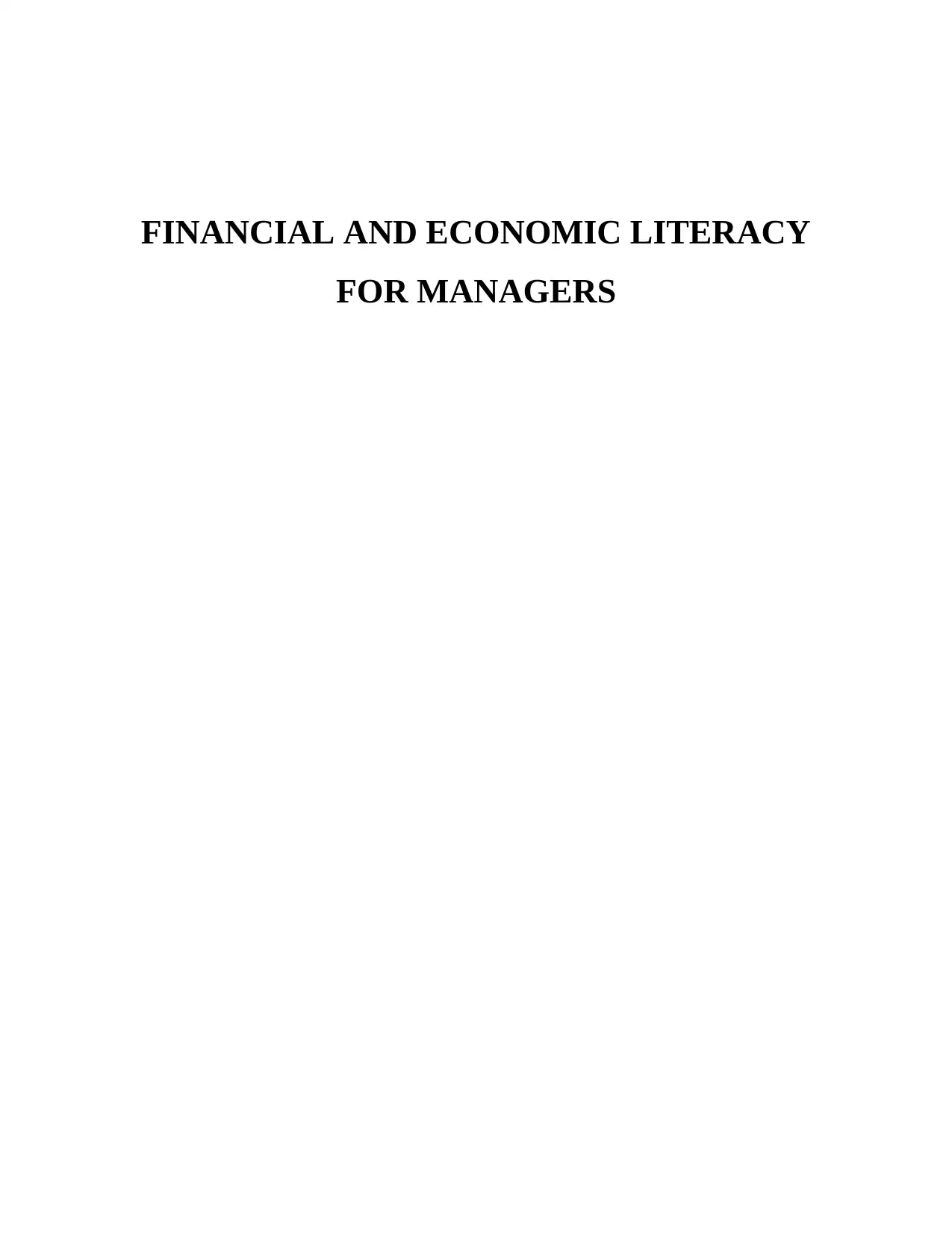
FINANCIAL AND ECONOMIC LITERACY
FOR MANAGERS
FOR MANAGERS
Secure Best Marks with AI Grader
Need help grading? Try our AI Grader for instant feedback on your assignments.
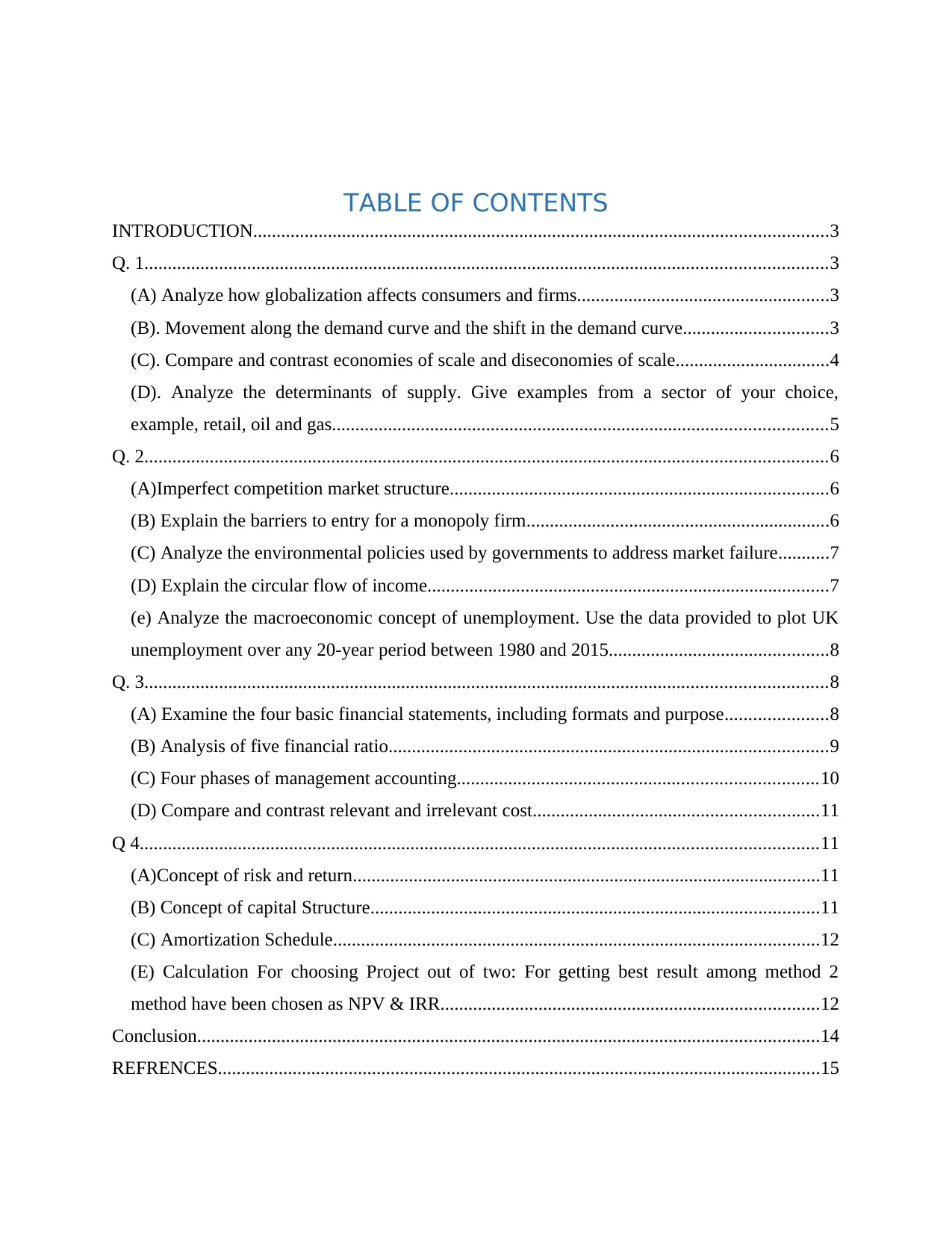
TABLE OF CONTENTS
INTRODUCTION...........................................................................................................................3
Q. 1..................................................................................................................................................3
(A) Analyze how globalization affects consumers and firms......................................................3
(B). Movement along the demand curve and the shift in the demand curve...............................3
(C). Compare and contrast economies of scale and diseconomies of scale.................................4
(D). Analyze the determinants of supply. Give examples from a sector of your choice,
example, retail, oil and gas..........................................................................................................5
Q. 2..................................................................................................................................................6
(A)Imperfect competition market structure.................................................................................6
(B) Explain the barriers to entry for a monopoly firm.................................................................6
(C) Analyze the environmental policies used by governments to address market failure...........7
(D) Explain the circular flow of income......................................................................................7
(e) Analyze the macroeconomic concept of unemployment. Use the data provided to plot UK
unemployment over any 20-year period between 1980 and 2015...............................................8
Q. 3..................................................................................................................................................8
(A) Examine the four basic financial statements, including formats and purpose......................8
(B) Analysis of five financial ratio..............................................................................................9
(C) Four phases of management accounting.............................................................................10
(D) Compare and contrast relevant and irrelevant cost.............................................................11
Q 4.................................................................................................................................................11
(A)Concept of risk and return....................................................................................................11
(B) Concept of capital Structure................................................................................................11
(C) Amortization Schedule........................................................................................................12
(E) Calculation For choosing Project out of two: For getting best result among method 2
method have been chosen as NPV & IRR.................................................................................12
Conclusion.....................................................................................................................................14
REFRENCES.................................................................................................................................15
INTRODUCTION...........................................................................................................................3
Q. 1..................................................................................................................................................3
(A) Analyze how globalization affects consumers and firms......................................................3
(B). Movement along the demand curve and the shift in the demand curve...............................3
(C). Compare and contrast economies of scale and diseconomies of scale.................................4
(D). Analyze the determinants of supply. Give examples from a sector of your choice,
example, retail, oil and gas..........................................................................................................5
Q. 2..................................................................................................................................................6
(A)Imperfect competition market structure.................................................................................6
(B) Explain the barriers to entry for a monopoly firm.................................................................6
(C) Analyze the environmental policies used by governments to address market failure...........7
(D) Explain the circular flow of income......................................................................................7
(e) Analyze the macroeconomic concept of unemployment. Use the data provided to plot UK
unemployment over any 20-year period between 1980 and 2015...............................................8
Q. 3..................................................................................................................................................8
(A) Examine the four basic financial statements, including formats and purpose......................8
(B) Analysis of five financial ratio..............................................................................................9
(C) Four phases of management accounting.............................................................................10
(D) Compare and contrast relevant and irrelevant cost.............................................................11
Q 4.................................................................................................................................................11
(A)Concept of risk and return....................................................................................................11
(B) Concept of capital Structure................................................................................................11
(C) Amortization Schedule........................................................................................................12
(E) Calculation For choosing Project out of two: For getting best result among method 2
method have been chosen as NPV & IRR.................................................................................12
Conclusion.....................................................................................................................................14
REFRENCES.................................................................................................................................15
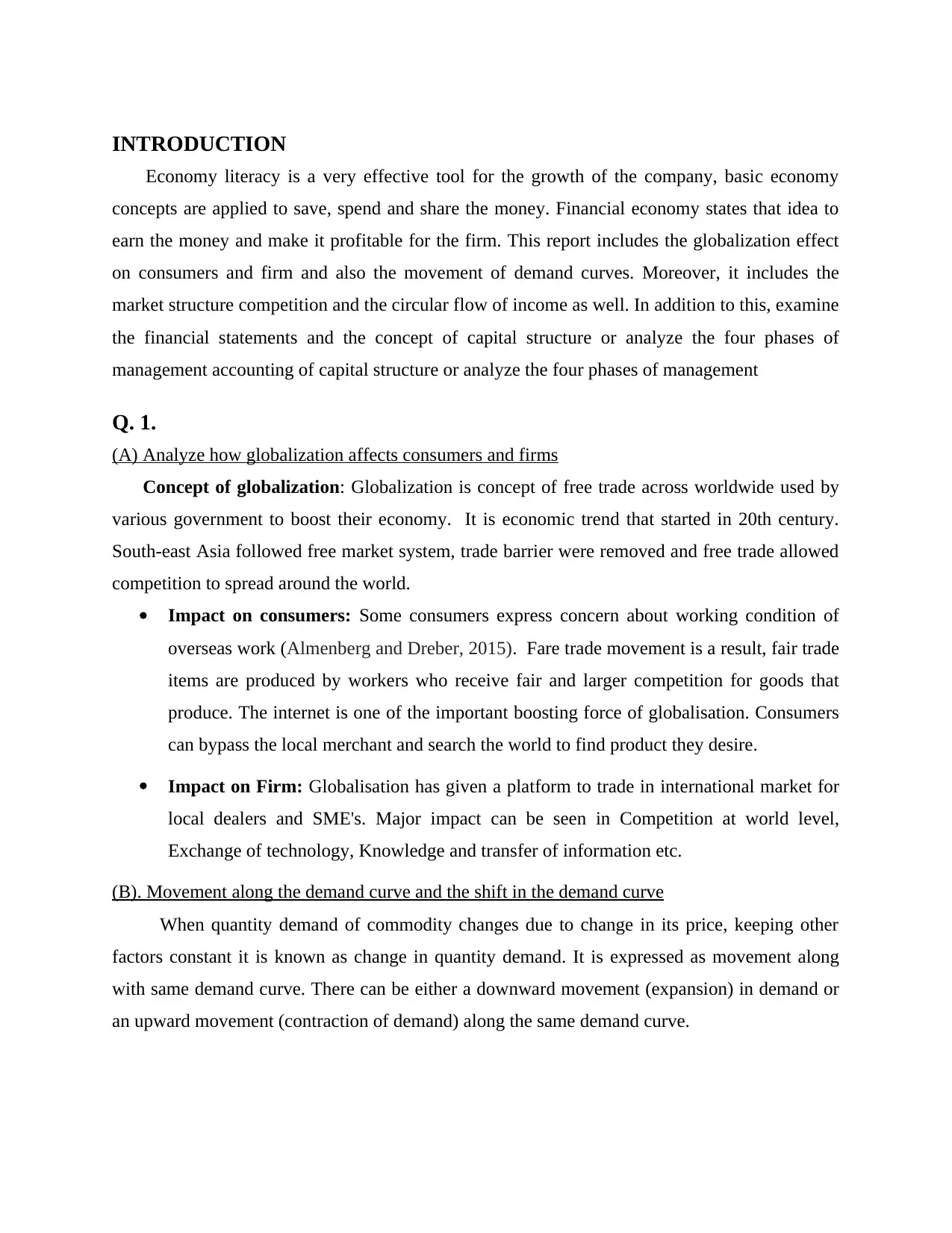
INTRODUCTION
Economy literacy is a very effective tool for the growth of the company, basic economy
concepts are applied to save, spend and share the money. Financial economy states that idea to
earn the money and make it profitable for the firm. This report includes the globalization effect
on consumers and firm and also the movement of demand curves. Moreover, it includes the
market structure competition and the circular flow of income as well. In addition to this, examine
the financial statements and the concept of capital structure or analyze the four phases of
management accounting of capital structure or analyze the four phases of management
Q. 1.
(A) Analyze how globalization affects consumers and firms
Concept of globalization: Globalization is concept of free trade across worldwide used by
various government to boost their economy. It is economic trend that started in 20th century.
South-east Asia followed free market system, trade barrier were removed and free trade allowed
competition to spread around the world.
Impact on consumers: Some consumers express concern about working condition of
overseas work (Almenberg and Dreber, 2015). Fare trade movement is a result, fair trade
items are produced by workers who receive fair and larger competition for goods that
produce. The internet is one of the important boosting force of globalisation. Consumers
can bypass the local merchant and search the world to find product they desire.
Impact on Firm: Globalisation has given a platform to trade in international market for
local dealers and SME's. Major impact can be seen in Competition at world level,
Exchange of technology, Knowledge and transfer of information etc.
(B). Movement along the demand curve and the shift in the demand curve
When quantity demand of commodity changes due to change in its price, keeping other
factors constant it is known as change in quantity demand. It is expressed as movement along
with same demand curve. There can be either a downward movement (expansion) in demand or
an upward movement (contraction of demand) along the same demand curve.
Economy literacy is a very effective tool for the growth of the company, basic economy
concepts are applied to save, spend and share the money. Financial economy states that idea to
earn the money and make it profitable for the firm. This report includes the globalization effect
on consumers and firm and also the movement of demand curves. Moreover, it includes the
market structure competition and the circular flow of income as well. In addition to this, examine
the financial statements and the concept of capital structure or analyze the four phases of
management accounting of capital structure or analyze the four phases of management
Q. 1.
(A) Analyze how globalization affects consumers and firms
Concept of globalization: Globalization is concept of free trade across worldwide used by
various government to boost their economy. It is economic trend that started in 20th century.
South-east Asia followed free market system, trade barrier were removed and free trade allowed
competition to spread around the world.
Impact on consumers: Some consumers express concern about working condition of
overseas work (Almenberg and Dreber, 2015). Fare trade movement is a result, fair trade
items are produced by workers who receive fair and larger competition for goods that
produce. The internet is one of the important boosting force of globalisation. Consumers
can bypass the local merchant and search the world to find product they desire.
Impact on Firm: Globalisation has given a platform to trade in international market for
local dealers and SME's. Major impact can be seen in Competition at world level,
Exchange of technology, Knowledge and transfer of information etc.
(B). Movement along the demand curve and the shift in the demand curve
When quantity demand of commodity changes due to change in its price, keeping other
factors constant it is known as change in quantity demand. It is expressed as movement along
with same demand curve. There can be either a downward movement (expansion) in demand or
an upward movement (contraction of demand) along the same demand curve.
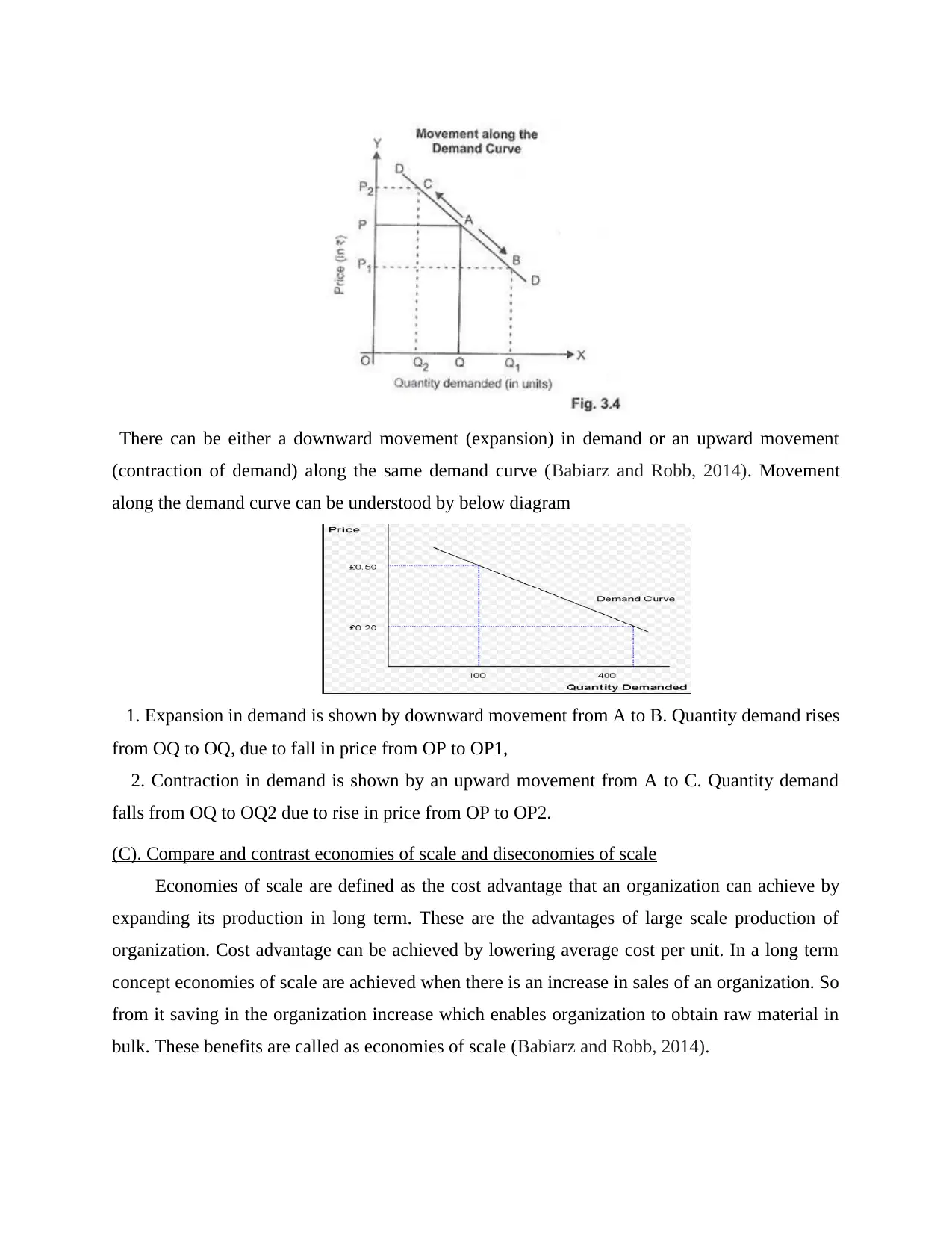
There can be either a downward movement (expansion) in demand or an upward movement
(contraction of demand) along the same demand curve (Babiarz and Robb, 2014). Movement
along the demand curve can be understood by below diagram
1. Expansion in demand is shown by downward movement from A to B. Quantity demand rises
from OQ to OQ, due to fall in price from OP to OP1,
2. Contraction in demand is shown by an upward movement from A to C. Quantity demand
falls from OQ to OQ2 due to rise in price from OP to OP2.
(C). Compare and contrast economies of scale and diseconomies of scale
Economies of scale are defined as the cost advantage that an organization can achieve by
expanding its production in long term. These are the advantages of large scale production of
organization. Cost advantage can be achieved by lowering average cost per unit. In a long term
concept economies of scale are achieved when there is an increase in sales of an organization. So
from it saving in the organization increase which enables organization to obtain raw material in
bulk. These benefits are called as economies of scale (Babiarz and Robb, 2014).
(contraction of demand) along the same demand curve (Babiarz and Robb, 2014). Movement
along the demand curve can be understood by below diagram
1. Expansion in demand is shown by downward movement from A to B. Quantity demand rises
from OQ to OQ, due to fall in price from OP to OP1,
2. Contraction in demand is shown by an upward movement from A to C. Quantity demand
falls from OQ to OQ2 due to rise in price from OP to OP2.
(C). Compare and contrast economies of scale and diseconomies of scale
Economies of scale are defined as the cost advantage that an organization can achieve by
expanding its production in long term. These are the advantages of large scale production of
organization. Cost advantage can be achieved by lowering average cost per unit. In a long term
concept economies of scale are achieved when there is an increase in sales of an organization. So
from it saving in the organization increase which enables organization to obtain raw material in
bulk. These benefits are called as economies of scale (Babiarz and Robb, 2014).
Secure Best Marks with AI Grader
Need help grading? Try our AI Grader for instant feedback on your assignments.
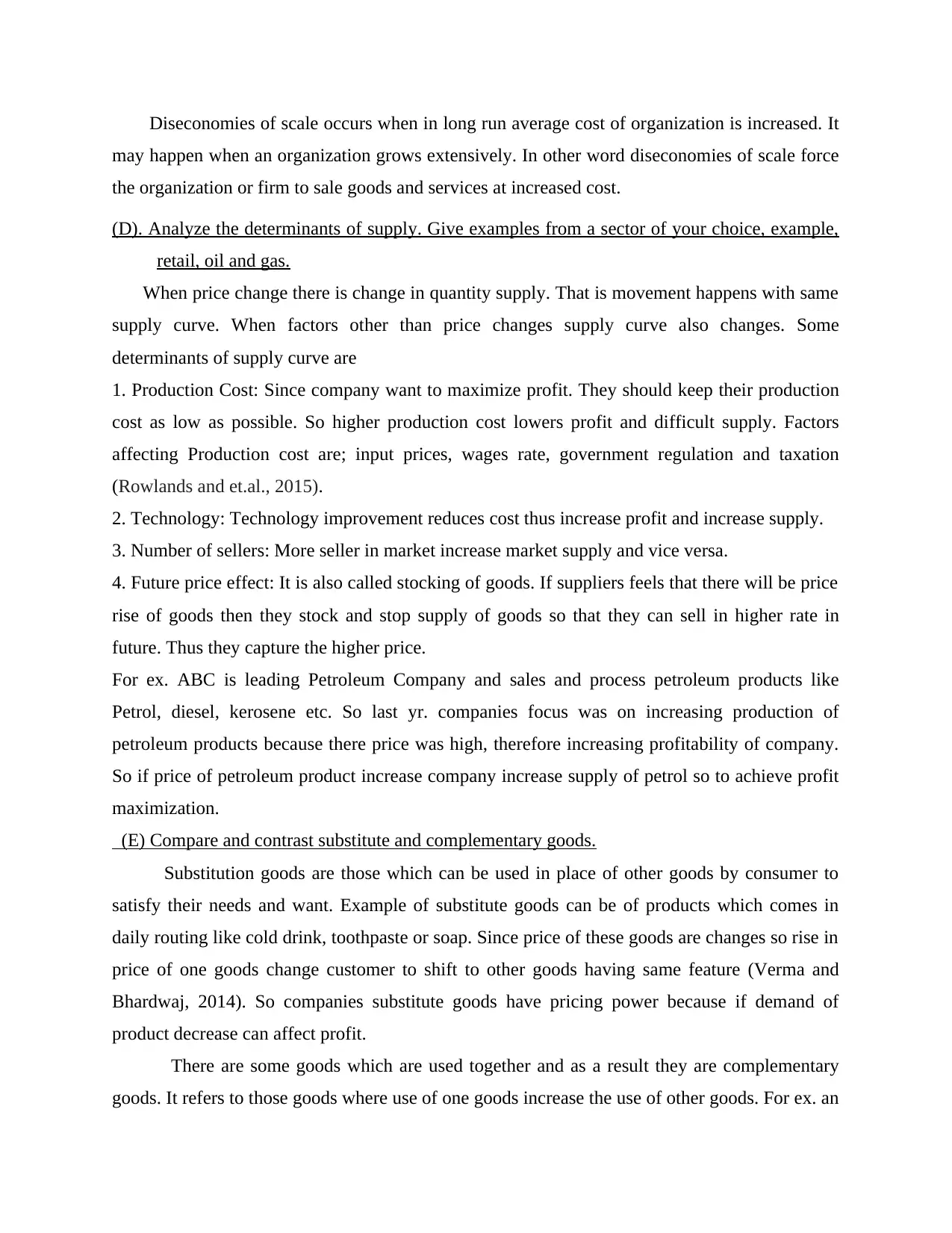
Diseconomies of scale occurs when in long run average cost of organization is increased. It
may happen when an organization grows extensively. In other word diseconomies of scale force
the organization or firm to sale goods and services at increased cost.
(D). Analyze the determinants of supply. Give examples from a sector of your choice, example,
retail, oil and gas.
When price change there is change in quantity supply. That is movement happens with same
supply curve. When factors other than price changes supply curve also changes. Some
determinants of supply curve are
1. Production Cost: Since company want to maximize profit. They should keep their production
cost as low as possible. So higher production cost lowers profit and difficult supply. Factors
affecting Production cost are; input prices, wages rate, government regulation and taxation
(Rowlands and et.al., 2015).
2. Technology: Technology improvement reduces cost thus increase profit and increase supply.
3. Number of sellers: More seller in market increase market supply and vice versa.
4. Future price effect: It is also called stocking of goods. If suppliers feels that there will be price
rise of goods then they stock and stop supply of goods so that they can sell in higher rate in
future. Thus they capture the higher price.
For ex. ABC is leading Petroleum Company and sales and process petroleum products like
Petrol, diesel, kerosene etc. So last yr. companies focus was on increasing production of
petroleum products because there price was high, therefore increasing profitability of company.
So if price of petroleum product increase company increase supply of petrol so to achieve profit
maximization.
(E) Compare and contrast substitute and complementary goods.
Substitution goods are those which can be used in place of other goods by consumer to
satisfy their needs and want. Example of substitute goods can be of products which comes in
daily routing like cold drink, toothpaste or soap. Since price of these goods are changes so rise in
price of one goods change customer to shift to other goods having same feature (Verma and
Bhardwaj, 2014). So companies substitute goods have pricing power because if demand of
product decrease can affect profit.
There are some goods which are used together and as a result they are complementary
goods. It refers to those goods where use of one goods increase the use of other goods. For ex. an
may happen when an organization grows extensively. In other word diseconomies of scale force
the organization or firm to sale goods and services at increased cost.
(D). Analyze the determinants of supply. Give examples from a sector of your choice, example,
retail, oil and gas.
When price change there is change in quantity supply. That is movement happens with same
supply curve. When factors other than price changes supply curve also changes. Some
determinants of supply curve are
1. Production Cost: Since company want to maximize profit. They should keep their production
cost as low as possible. So higher production cost lowers profit and difficult supply. Factors
affecting Production cost are; input prices, wages rate, government regulation and taxation
(Rowlands and et.al., 2015).
2. Technology: Technology improvement reduces cost thus increase profit and increase supply.
3. Number of sellers: More seller in market increase market supply and vice versa.
4. Future price effect: It is also called stocking of goods. If suppliers feels that there will be price
rise of goods then they stock and stop supply of goods so that they can sell in higher rate in
future. Thus they capture the higher price.
For ex. ABC is leading Petroleum Company and sales and process petroleum products like
Petrol, diesel, kerosene etc. So last yr. companies focus was on increasing production of
petroleum products because there price was high, therefore increasing profitability of company.
So if price of petroleum product increase company increase supply of petrol so to achieve profit
maximization.
(E) Compare and contrast substitute and complementary goods.
Substitution goods are those which can be used in place of other goods by consumer to
satisfy their needs and want. Example of substitute goods can be of products which comes in
daily routing like cold drink, toothpaste or soap. Since price of these goods are changes so rise in
price of one goods change customer to shift to other goods having same feature (Verma and
Bhardwaj, 2014). So companies substitute goods have pricing power because if demand of
product decrease can affect profit.
There are some goods which are used together and as a result they are complementary
goods. It refers to those goods where use of one goods increase the use of other goods. For ex. an
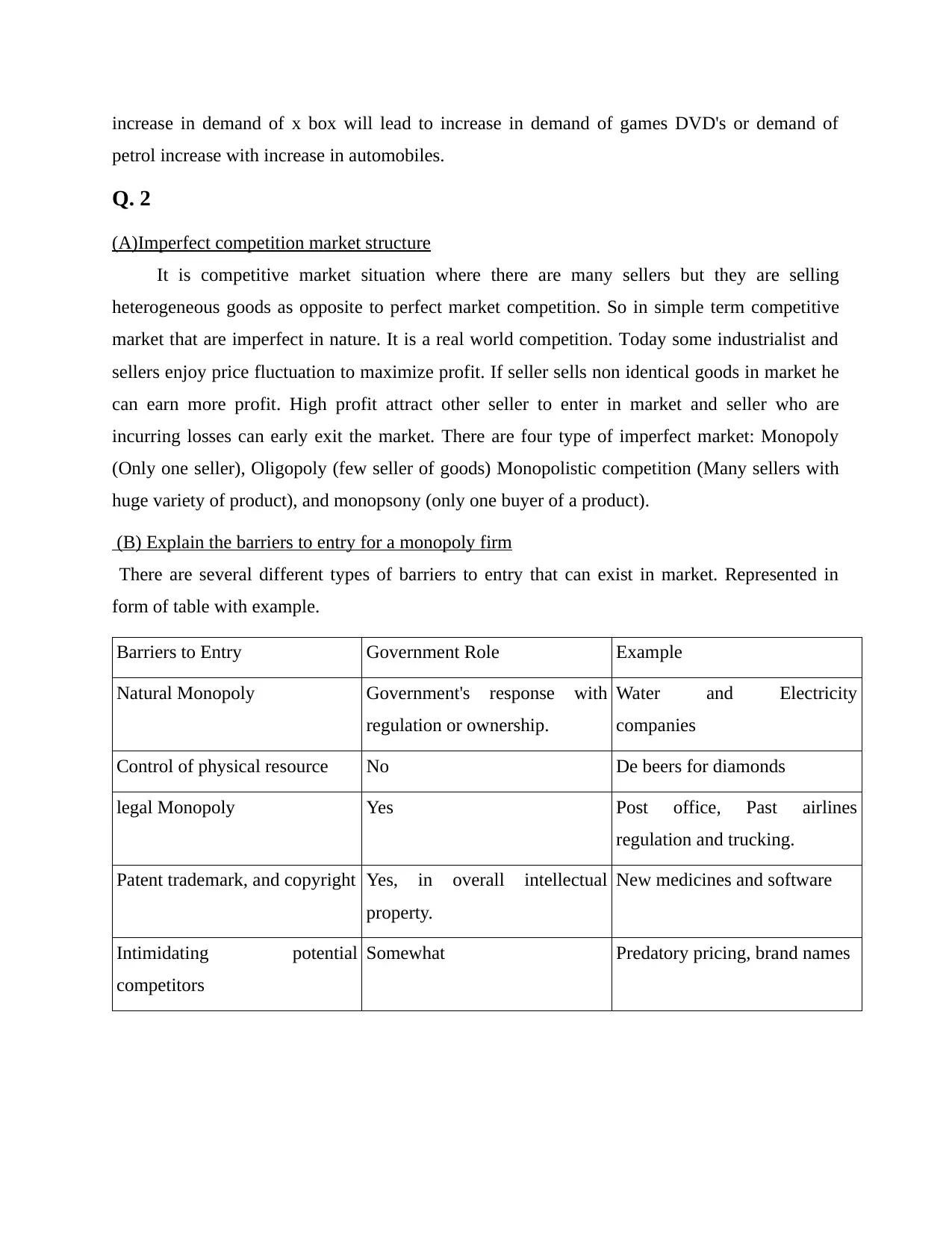
increase in demand of x box will lead to increase in demand of games DVD's or demand of
petrol increase with increase in automobiles.
Q. 2
(A)Imperfect competition market structure
It is competitive market situation where there are many sellers but they are selling
heterogeneous goods as opposite to perfect market competition. So in simple term competitive
market that are imperfect in nature. It is a real world competition. Today some industrialist and
sellers enjoy price fluctuation to maximize profit. If seller sells non identical goods in market he
can earn more profit. High profit attract other seller to enter in market and seller who are
incurring losses can early exit the market. There are four type of imperfect market: Monopoly
(Only one seller), Oligopoly (few seller of goods) Monopolistic competition (Many sellers with
huge variety of product), and monopsony (only one buyer of a product).
(B) Explain the barriers to entry for a monopoly firm
There are several different types of barriers to entry that can exist in market. Represented in
form of table with example.
Barriers to Entry Government Role Example
Natural Monopoly Government's response with
regulation or ownership.
Water and Electricity
companies
Control of physical resource No De beers for diamonds
legal Monopoly Yes Post office, Past airlines
regulation and trucking.
Patent trademark, and copyright Yes, in overall intellectual
property.
New medicines and software
Intimidating potential
competitors
Somewhat Predatory pricing, brand names
petrol increase with increase in automobiles.
Q. 2
(A)Imperfect competition market structure
It is competitive market situation where there are many sellers but they are selling
heterogeneous goods as opposite to perfect market competition. So in simple term competitive
market that are imperfect in nature. It is a real world competition. Today some industrialist and
sellers enjoy price fluctuation to maximize profit. If seller sells non identical goods in market he
can earn more profit. High profit attract other seller to enter in market and seller who are
incurring losses can early exit the market. There are four type of imperfect market: Monopoly
(Only one seller), Oligopoly (few seller of goods) Monopolistic competition (Many sellers with
huge variety of product), and monopsony (only one buyer of a product).
(B) Explain the barriers to entry for a monopoly firm
There are several different types of barriers to entry that can exist in market. Represented in
form of table with example.
Barriers to Entry Government Role Example
Natural Monopoly Government's response with
regulation or ownership.
Water and Electricity
companies
Control of physical resource No De beers for diamonds
legal Monopoly Yes Post office, Past airlines
regulation and trucking.
Patent trademark, and copyright Yes, in overall intellectual
property.
New medicines and software
Intimidating potential
competitors
Somewhat Predatory pricing, brand names
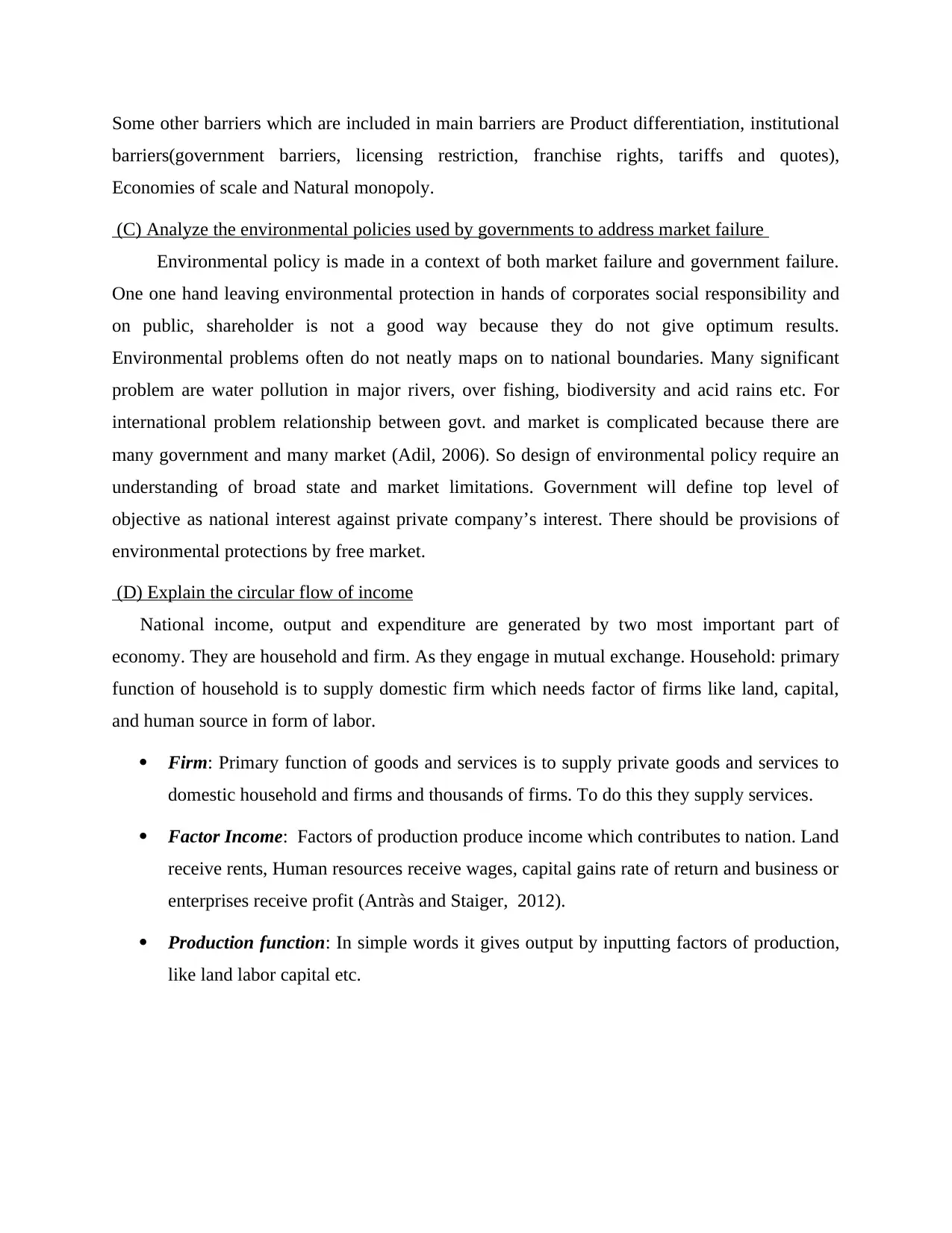
Some other barriers which are included in main barriers are Product differentiation, institutional
barriers(government barriers, licensing restriction, franchise rights, tariffs and quotes),
Economies of scale and Natural monopoly.
(C) Analyze the environmental policies used by governments to address market failure
Environmental policy is made in a context of both market failure and government failure.
One one hand leaving environmental protection in hands of corporates social responsibility and
on public, shareholder is not a good way because they do not give optimum results.
Environmental problems often do not neatly maps on to national boundaries. Many significant
problem are water pollution in major rivers, over fishing, biodiversity and acid rains etc. For
international problem relationship between govt. and market is complicated because there are
many government and many market (Adil, 2006). So design of environmental policy require an
understanding of broad state and market limitations. Government will define top level of
objective as national interest against private company’s interest. There should be provisions of
environmental protections by free market.
(D) Explain the circular flow of income
National income, output and expenditure are generated by two most important part of
economy. They are household and firm. As they engage in mutual exchange. Household: primary
function of household is to supply domestic firm which needs factor of firms like land, capital,
and human source in form of labor.
Firm: Primary function of goods and services is to supply private goods and services to
domestic household and firms and thousands of firms. To do this they supply services.
Factor Income: Factors of production produce income which contributes to nation. Land
receive rents, Human resources receive wages, capital gains rate of return and business or
enterprises receive profit (Antràs and Staiger, 2012).
Production function: In simple words it gives output by inputting factors of production,
like land labor capital etc.
barriers(government barriers, licensing restriction, franchise rights, tariffs and quotes),
Economies of scale and Natural monopoly.
(C) Analyze the environmental policies used by governments to address market failure
Environmental policy is made in a context of both market failure and government failure.
One one hand leaving environmental protection in hands of corporates social responsibility and
on public, shareholder is not a good way because they do not give optimum results.
Environmental problems often do not neatly maps on to national boundaries. Many significant
problem are water pollution in major rivers, over fishing, biodiversity and acid rains etc. For
international problem relationship between govt. and market is complicated because there are
many government and many market (Adil, 2006). So design of environmental policy require an
understanding of broad state and market limitations. Government will define top level of
objective as national interest against private company’s interest. There should be provisions of
environmental protections by free market.
(D) Explain the circular flow of income
National income, output and expenditure are generated by two most important part of
economy. They are household and firm. As they engage in mutual exchange. Household: primary
function of household is to supply domestic firm which needs factor of firms like land, capital,
and human source in form of labor.
Firm: Primary function of goods and services is to supply private goods and services to
domestic household and firms and thousands of firms. To do this they supply services.
Factor Income: Factors of production produce income which contributes to nation. Land
receive rents, Human resources receive wages, capital gains rate of return and business or
enterprises receive profit (Antràs and Staiger, 2012).
Production function: In simple words it gives output by inputting factors of production,
like land labor capital etc.
Paraphrase This Document
Need a fresh take? Get an instant paraphrase of this document with our AI Paraphraser
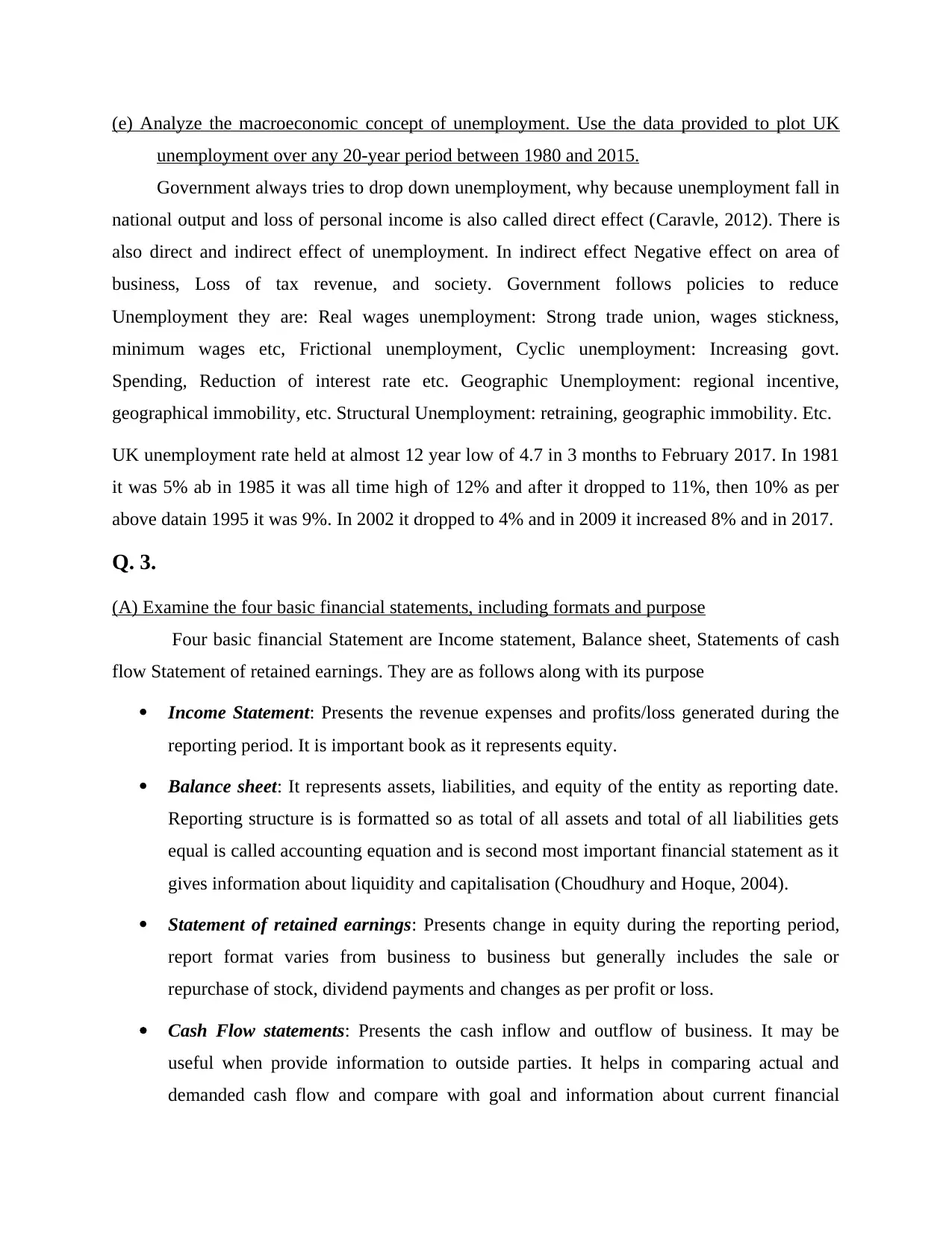
(e) Analyze the macroeconomic concept of unemployment. Use the data provided to plot UK
unemployment over any 20-year period between 1980 and 2015.
Government always tries to drop down unemployment, why because unemployment fall in
national output and loss of personal income is also called direct effect (Caravle, 2012). There is
also direct and indirect effect of unemployment. In indirect effect Negative effect on area of
business, Loss of tax revenue, and society. Government follows policies to reduce
Unemployment they are: Real wages unemployment: Strong trade union, wages stickness,
minimum wages etc, Frictional unemployment, Cyclic unemployment: Increasing govt.
Spending, Reduction of interest rate etc. Geographic Unemployment: regional incentive,
geographical immobility, etc. Structural Unemployment: retraining, geographic immobility. Etc.
UK unemployment rate held at almost 12 year low of 4.7 in 3 months to February 2017. In 1981
it was 5% ab in 1985 it was all time high of 12% and after it dropped to 11%, then 10% as per
above datain 1995 it was 9%. In 2002 it dropped to 4% and in 2009 it increased 8% and in 2017.
Q. 3.
(A) Examine the four basic financial statements, including formats and purpose
Four basic financial Statement are Income statement, Balance sheet, Statements of cash
flow Statement of retained earnings. They are as follows along with its purpose
Income Statement: Presents the revenue expenses and profits/loss generated during the
reporting period. It is important book as it represents equity.
Balance sheet: It represents assets, liabilities, and equity of the entity as reporting date.
Reporting structure is is formatted so as total of all assets and total of all liabilities gets
equal is called accounting equation and is second most important financial statement as it
gives information about liquidity and capitalisation (Choudhury and Hoque, 2004).
Statement of retained earnings: Presents change in equity during the reporting period,
report format varies from business to business but generally includes the sale or
repurchase of stock, dividend payments and changes as per profit or loss.
Cash Flow statements: Presents the cash inflow and outflow of business. It may be
useful when provide information to outside parties. It helps in comparing actual and
demanded cash flow and compare with goal and information about current financial
unemployment over any 20-year period between 1980 and 2015.
Government always tries to drop down unemployment, why because unemployment fall in
national output and loss of personal income is also called direct effect (Caravle, 2012). There is
also direct and indirect effect of unemployment. In indirect effect Negative effect on area of
business, Loss of tax revenue, and society. Government follows policies to reduce
Unemployment they are: Real wages unemployment: Strong trade union, wages stickness,
minimum wages etc, Frictional unemployment, Cyclic unemployment: Increasing govt.
Spending, Reduction of interest rate etc. Geographic Unemployment: regional incentive,
geographical immobility, etc. Structural Unemployment: retraining, geographic immobility. Etc.
UK unemployment rate held at almost 12 year low of 4.7 in 3 months to February 2017. In 1981
it was 5% ab in 1985 it was all time high of 12% and after it dropped to 11%, then 10% as per
above datain 1995 it was 9%. In 2002 it dropped to 4% and in 2009 it increased 8% and in 2017.
Q. 3.
(A) Examine the four basic financial statements, including formats and purpose
Four basic financial Statement are Income statement, Balance sheet, Statements of cash
flow Statement of retained earnings. They are as follows along with its purpose
Income Statement: Presents the revenue expenses and profits/loss generated during the
reporting period. It is important book as it represents equity.
Balance sheet: It represents assets, liabilities, and equity of the entity as reporting date.
Reporting structure is is formatted so as total of all assets and total of all liabilities gets
equal is called accounting equation and is second most important financial statement as it
gives information about liquidity and capitalisation (Choudhury and Hoque, 2004).
Statement of retained earnings: Presents change in equity during the reporting period,
report format varies from business to business but generally includes the sale or
repurchase of stock, dividend payments and changes as per profit or loss.
Cash Flow statements: Presents the cash inflow and outflow of business. It may be
useful when provide information to outside parties. It helps in comparing actual and
demanded cash flow and compare with goal and information about current financial
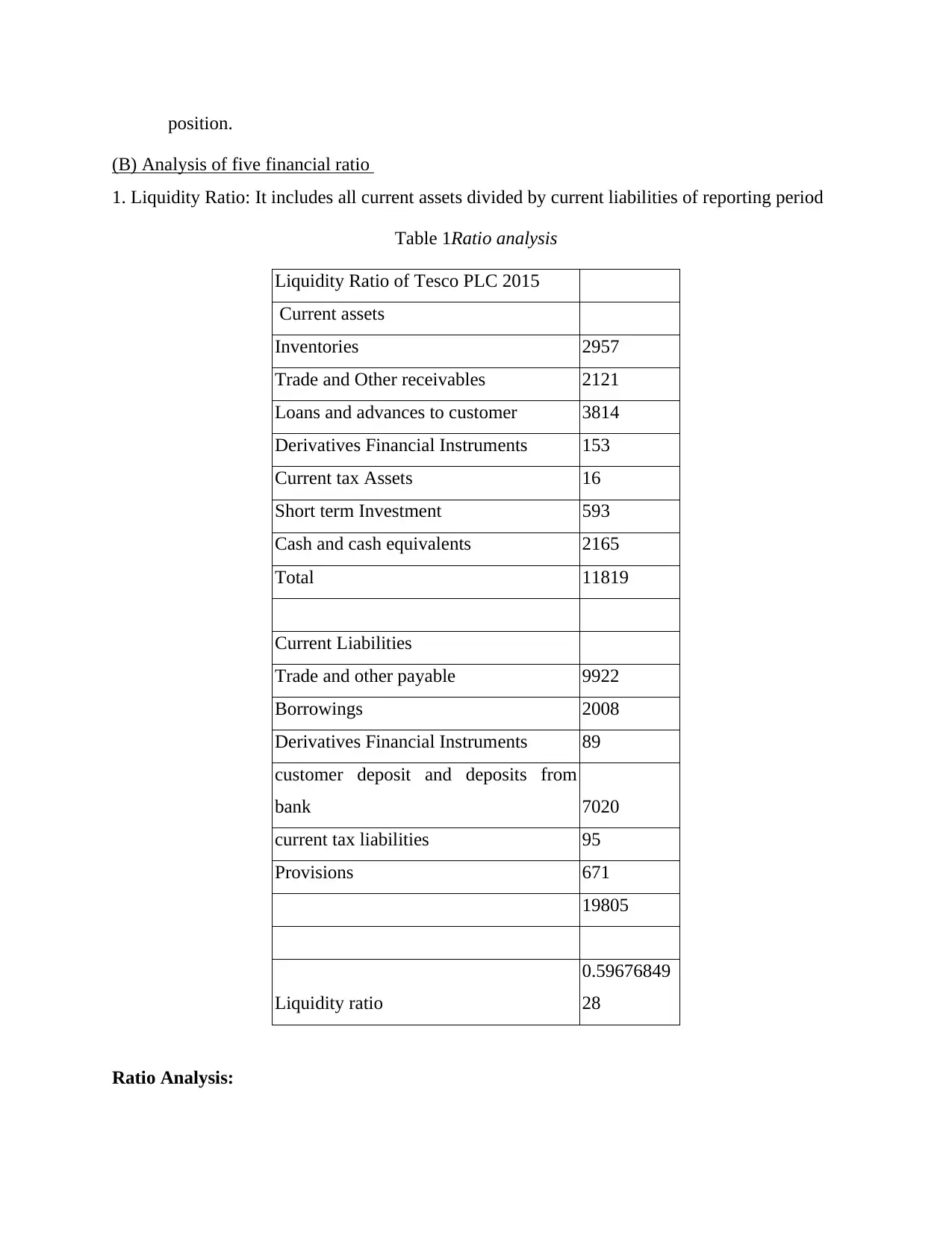
position.
(B) Analysis of five financial ratio
1. Liquidity Ratio: It includes all current assets divided by current liabilities of reporting period
Table 1Ratio analysis
Liquidity Ratio of Tesco PLC 2015
Current assets
Inventories 2957
Trade and Other receivables 2121
Loans and advances to customer 3814
Derivatives Financial Instruments 153
Current tax Assets 16
Short term Investment 593
Cash and cash equivalents 2165
Total 11819
Current Liabilities
Trade and other payable 9922
Borrowings 2008
Derivatives Financial Instruments 89
customer deposit and deposits from
bank 7020
current tax liabilities 95
Provisions 671
19805
Liquidity ratio
0.59676849
28
Ratio Analysis:
(B) Analysis of five financial ratio
1. Liquidity Ratio: It includes all current assets divided by current liabilities of reporting period
Table 1Ratio analysis
Liquidity Ratio of Tesco PLC 2015
Current assets
Inventories 2957
Trade and Other receivables 2121
Loans and advances to customer 3814
Derivatives Financial Instruments 153
Current tax Assets 16
Short term Investment 593
Cash and cash equivalents 2165
Total 11819
Current Liabilities
Trade and other payable 9922
Borrowings 2008
Derivatives Financial Instruments 89
customer deposit and deposits from
bank 7020
current tax liabilities 95
Provisions 671
19805
Liquidity ratio
0.59676849
28
Ratio Analysis:
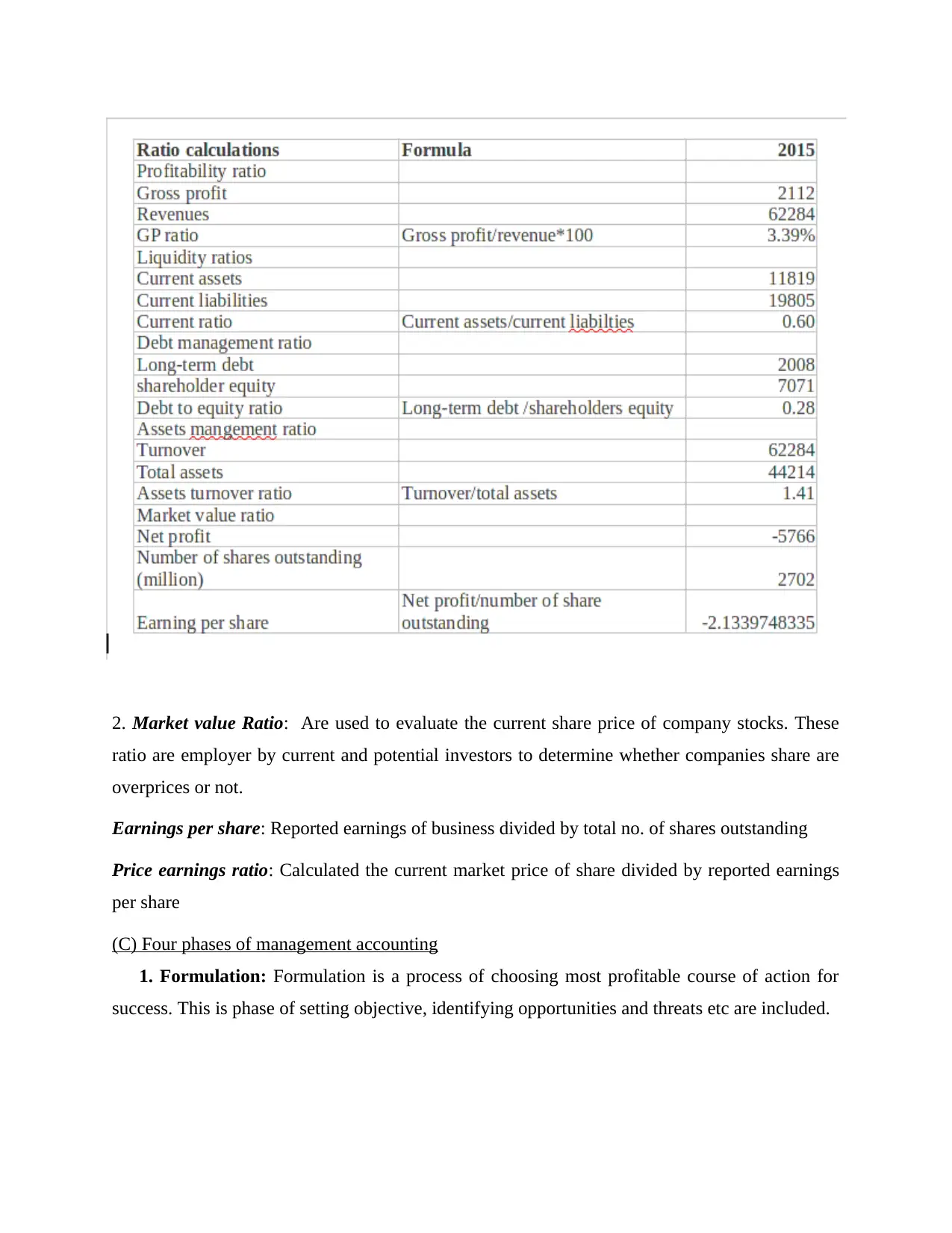
2. Market value Ratio: Are used to evaluate the current share price of company stocks. These
ratio are employer by current and potential investors to determine whether companies share are
overprices or not.
Earnings per share: Reported earnings of business divided by total no. of shares outstanding
Price earnings ratio: Calculated the current market price of share divided by reported earnings
per share
(C) Four phases of management accounting
1. Formulation: Formulation is a process of choosing most profitable course of action for
success. This is phase of setting objective, identifying opportunities and threats etc are included.
ratio are employer by current and potential investors to determine whether companies share are
overprices or not.
Earnings per share: Reported earnings of business divided by total no. of shares outstanding
Price earnings ratio: Calculated the current market price of share divided by reported earnings
per share
(C) Four phases of management accounting
1. Formulation: Formulation is a process of choosing most profitable course of action for
success. This is phase of setting objective, identifying opportunities and threats etc are included.
Secure Best Marks with AI Grader
Need help grading? Try our AI Grader for instant feedback on your assignments.
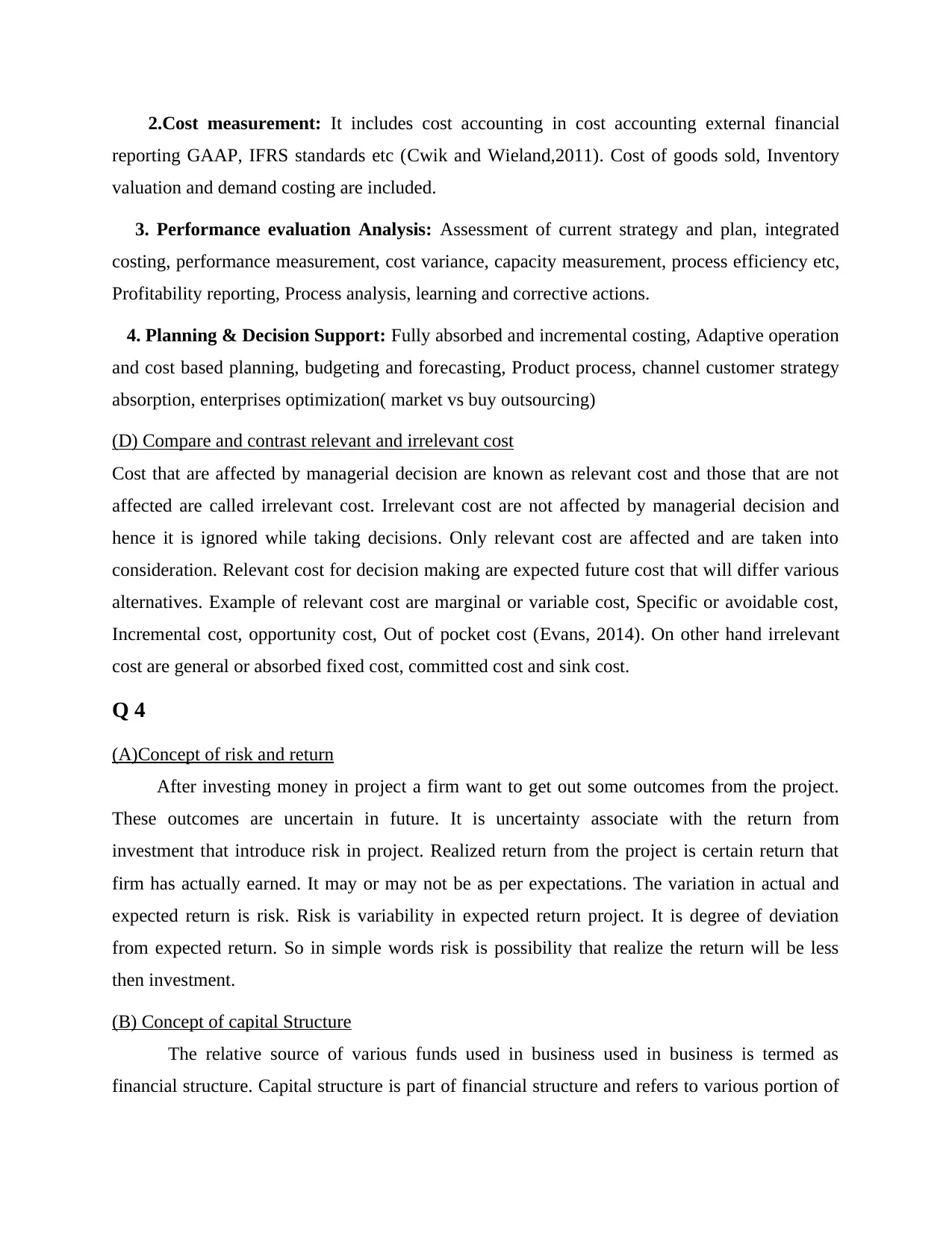
2.Cost measurement: It includes cost accounting in cost accounting external financial
reporting GAAP, IFRS standards etc (Cwik and Wieland,2011). Cost of goods sold, Inventory
valuation and demand costing are included.
3. Performance evaluation Analysis: Assessment of current strategy and plan, integrated
costing, performance measurement, cost variance, capacity measurement, process efficiency etc,
Profitability reporting, Process analysis, learning and corrective actions.
4. Planning & Decision Support: Fully absorbed and incremental costing, Adaptive operation
and cost based planning, budgeting and forecasting, Product process, channel customer strategy
absorption, enterprises optimization( market vs buy outsourcing)
(D) Compare and contrast relevant and irrelevant cost
Cost that are affected by managerial decision are known as relevant cost and those that are not
affected are called irrelevant cost. Irrelevant cost are not affected by managerial decision and
hence it is ignored while taking decisions. Only relevant cost are affected and are taken into
consideration. Relevant cost for decision making are expected future cost that will differ various
alternatives. Example of relevant cost are marginal or variable cost, Specific or avoidable cost,
Incremental cost, opportunity cost, Out of pocket cost (Evans, 2014). On other hand irrelevant
cost are general or absorbed fixed cost, committed cost and sink cost.
Q 4
(A)Concept of risk and return
After investing money in project a firm want to get out some outcomes from the project.
These outcomes are uncertain in future. It is uncertainty associate with the return from
investment that introduce risk in project. Realized return from the project is certain return that
firm has actually earned. It may or may not be as per expectations. The variation in actual and
expected return is risk. Risk is variability in expected return project. It is degree of deviation
from expected return. So in simple words risk is possibility that realize the return will be less
then investment.
(B) Concept of capital Structure
The relative source of various funds used in business used in business is termed as
financial structure. Capital structure is part of financial structure and refers to various portion of
reporting GAAP, IFRS standards etc (Cwik and Wieland,2011). Cost of goods sold, Inventory
valuation and demand costing are included.
3. Performance evaluation Analysis: Assessment of current strategy and plan, integrated
costing, performance measurement, cost variance, capacity measurement, process efficiency etc,
Profitability reporting, Process analysis, learning and corrective actions.
4. Planning & Decision Support: Fully absorbed and incremental costing, Adaptive operation
and cost based planning, budgeting and forecasting, Product process, channel customer strategy
absorption, enterprises optimization( market vs buy outsourcing)
(D) Compare and contrast relevant and irrelevant cost
Cost that are affected by managerial decision are known as relevant cost and those that are not
affected are called irrelevant cost. Irrelevant cost are not affected by managerial decision and
hence it is ignored while taking decisions. Only relevant cost are affected and are taken into
consideration. Relevant cost for decision making are expected future cost that will differ various
alternatives. Example of relevant cost are marginal or variable cost, Specific or avoidable cost,
Incremental cost, opportunity cost, Out of pocket cost (Evans, 2014). On other hand irrelevant
cost are general or absorbed fixed cost, committed cost and sink cost.
Q 4
(A)Concept of risk and return
After investing money in project a firm want to get out some outcomes from the project.
These outcomes are uncertain in future. It is uncertainty associate with the return from
investment that introduce risk in project. Realized return from the project is certain return that
firm has actually earned. It may or may not be as per expectations. The variation in actual and
expected return is risk. Risk is variability in expected return project. It is degree of deviation
from expected return. So in simple words risk is possibility that realize the return will be less
then investment.
(B) Concept of capital Structure
The relative source of various funds used in business used in business is termed as
financial structure. Capital structure is part of financial structure and refers to various portion of
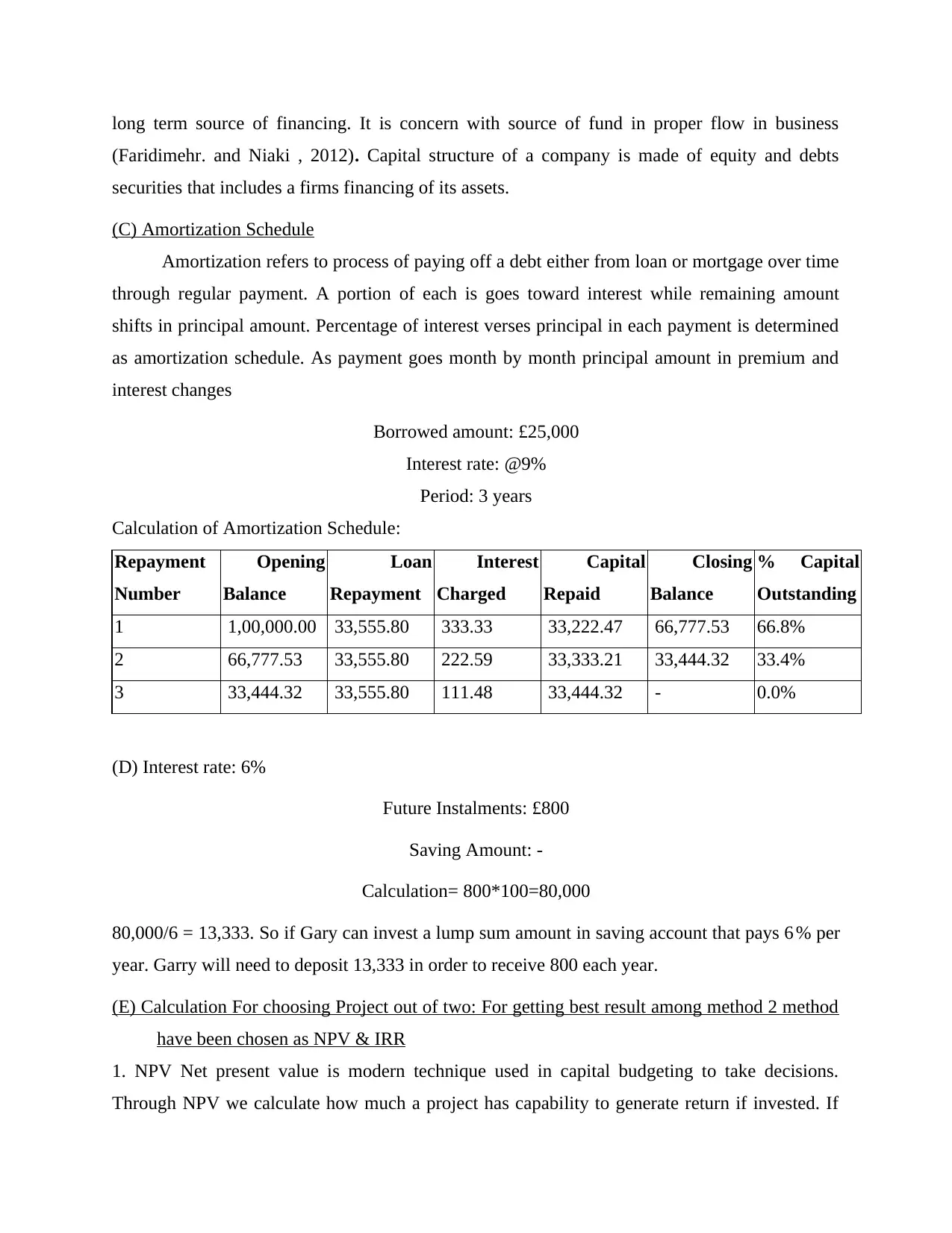
long term source of financing. It is concern with source of fund in proper flow in business
(Faridimehr. and Niaki , 2012). Capital structure of a company is made of equity and debts
securities that includes a firms financing of its assets.
(C) Amortization Schedule
Amortization refers to process of paying off a debt either from loan or mortgage over time
through regular payment. A portion of each is goes toward interest while remaining amount
shifts in principal amount. Percentage of interest verses principal in each payment is determined
as amortization schedule. As payment goes month by month principal amount in premium and
interest changes
Borrowed amount: £25,000
Interest rate: @9%
Period: 3 years
Calculation of Amortization Schedule:
Repayment
Number
Opening
Balance
Loan
Repayment
Interest
Charged
Capital
Repaid
Closing
Balance
% Capital
Outstanding
1 1,00,000.00 33,555.80 333.33 33,222.47 66,777.53 66.8%
2 66,777.53 33,555.80 222.59 33,333.21 33,444.32 33.4%
3 33,444.32 33,555.80 111.48 33,444.32 - 0.0%
(D) Interest rate: 6%
Future Instalments: £800
Saving Amount: -
Calculation= 800*100=80,000
80,000/6 = 13,333. So if Gary can invest a lump sum amount in saving account that pays 6 % per
year. Garry will need to deposit 13,333 in order to receive 800 each year.
(E) Calculation For choosing Project out of two: For getting best result among method 2 method
have been chosen as NPV & IRR
1. NPV Net present value is modern technique used in capital budgeting to take decisions.
Through NPV we calculate how much a project has capability to generate return if invested. If
(Faridimehr. and Niaki , 2012). Capital structure of a company is made of equity and debts
securities that includes a firms financing of its assets.
(C) Amortization Schedule
Amortization refers to process of paying off a debt either from loan or mortgage over time
through regular payment. A portion of each is goes toward interest while remaining amount
shifts in principal amount. Percentage of interest verses principal in each payment is determined
as amortization schedule. As payment goes month by month principal amount in premium and
interest changes
Borrowed amount: £25,000
Interest rate: @9%
Period: 3 years
Calculation of Amortization Schedule:
Repayment
Number
Opening
Balance
Loan
Repayment
Interest
Charged
Capital
Repaid
Closing
Balance
% Capital
Outstanding
1 1,00,000.00 33,555.80 333.33 33,222.47 66,777.53 66.8%
2 66,777.53 33,555.80 222.59 33,333.21 33,444.32 33.4%
3 33,444.32 33,555.80 111.48 33,444.32 - 0.0%
(D) Interest rate: 6%
Future Instalments: £800
Saving Amount: -
Calculation= 800*100=80,000
80,000/6 = 13,333. So if Gary can invest a lump sum amount in saving account that pays 6 % per
year. Garry will need to deposit 13,333 in order to receive 800 each year.
(E) Calculation For choosing Project out of two: For getting best result among method 2 method
have been chosen as NPV & IRR
1. NPV Net present value is modern technique used in capital budgeting to take decisions.
Through NPV we calculate how much a project has capability to generate return if invested. If
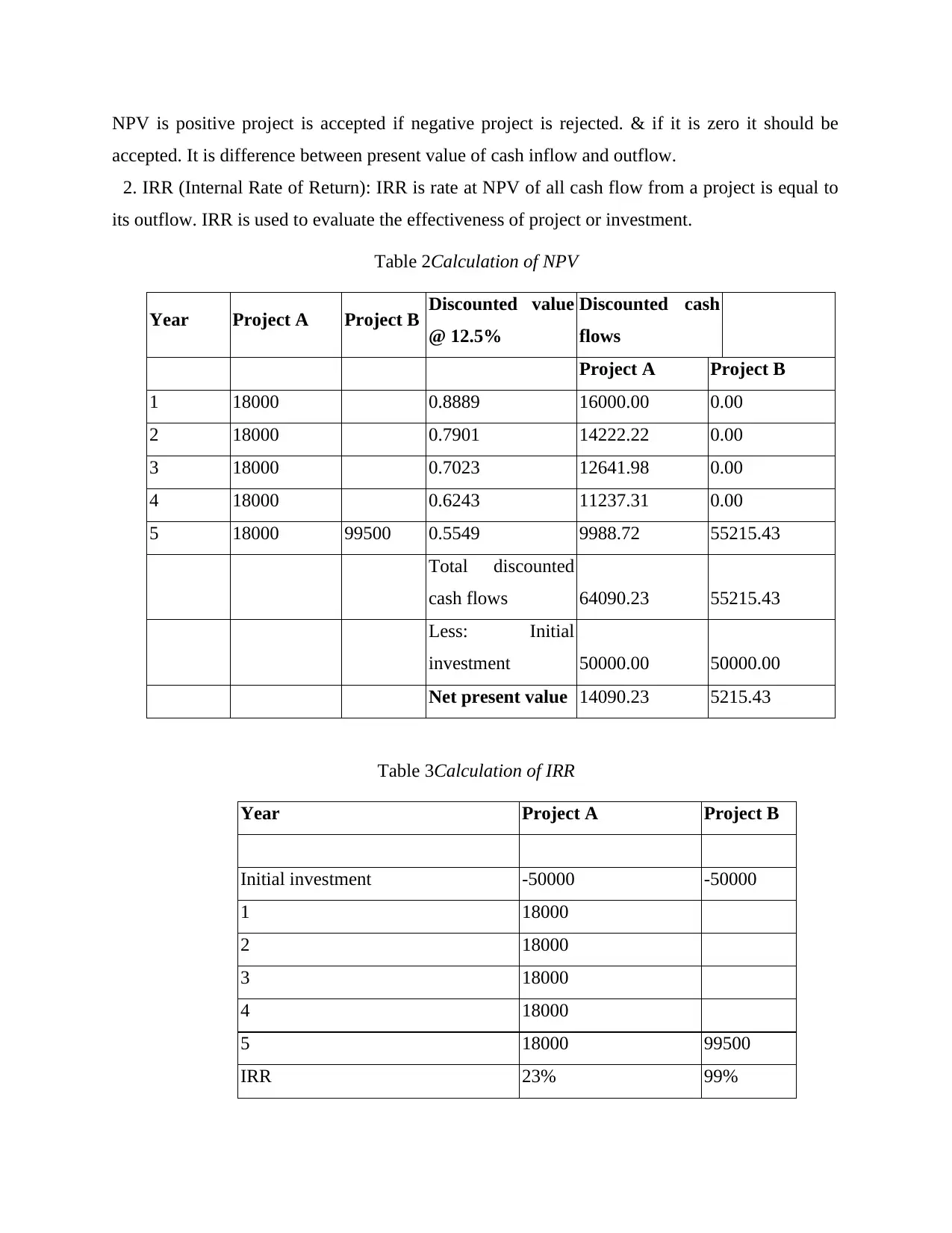
NPV is positive project is accepted if negative project is rejected. & if it is zero it should be
accepted. It is difference between present value of cash inflow and outflow.
2. IRR (Internal Rate of Return): IRR is rate at NPV of all cash flow from a project is equal to
its outflow. IRR is used to evaluate the effectiveness of project or investment.
Table 2Calculation of NPV
Year Project A Project B Discounted value
@ 12.5%
Discounted cash
flows
Project A Project B
1 18000 0.8889 16000.00 0.00
2 18000 0.7901 14222.22 0.00
3 18000 0.7023 12641.98 0.00
4 18000 0.6243 11237.31 0.00
5 18000 99500 0.5549 9988.72 55215.43
Total discounted
cash flows 64090.23 55215.43
Less: Initial
investment 50000.00 50000.00
Net present value 14090.23 5215.43
Table 3Calculation of IRR
Year Project A Project B
Initial investment -50000 -50000
1 18000
2 18000
3 18000
4 18000
5 18000 99500
IRR 23% 99%
accepted. It is difference between present value of cash inflow and outflow.
2. IRR (Internal Rate of Return): IRR is rate at NPV of all cash flow from a project is equal to
its outflow. IRR is used to evaluate the effectiveness of project or investment.
Table 2Calculation of NPV
Year Project A Project B Discounted value
@ 12.5%
Discounted cash
flows
Project A Project B
1 18000 0.8889 16000.00 0.00
2 18000 0.7901 14222.22 0.00
3 18000 0.7023 12641.98 0.00
4 18000 0.6243 11237.31 0.00
5 18000 99500 0.5549 9988.72 55215.43
Total discounted
cash flows 64090.23 55215.43
Less: Initial
investment 50000.00 50000.00
Net present value 14090.23 5215.43
Table 3Calculation of IRR
Year Project A Project B
Initial investment -50000 -50000
1 18000
2 18000
3 18000
4 18000
5 18000 99500
IRR 23% 99%
Paraphrase This Document
Need a fresh take? Get an instant paraphrase of this document with our AI Paraphraser

Conclusion
From this report it is cleared that globalization has huge impact on growth rate and
production rate in Tesco Firm at very large extent. Furthermore it has been concluded in demand
and supply curve at level of production at increasing demand then increase in price and
decreasing in demand then price also falls. Company’s economies and diseconomies of scale also
concluded in it. Imperfect competition market barrier of entries in monopoly and structure are
also studied. NPV and IRR method is included in study which is best method to apply in
organization. Lastly Risk and return also analyzed.
From this report it is cleared that globalization has huge impact on growth rate and
production rate in Tesco Firm at very large extent. Furthermore it has been concluded in demand
and supply curve at level of production at increasing demand then increase in price and
decreasing in demand then price also falls. Company’s economies and diseconomies of scale also
concluded in it. Imperfect competition market barrier of entries in monopoly and structure are
also studied. NPV and IRR method is included in study which is best method to apply in
organization. Lastly Risk and return also analyzed.
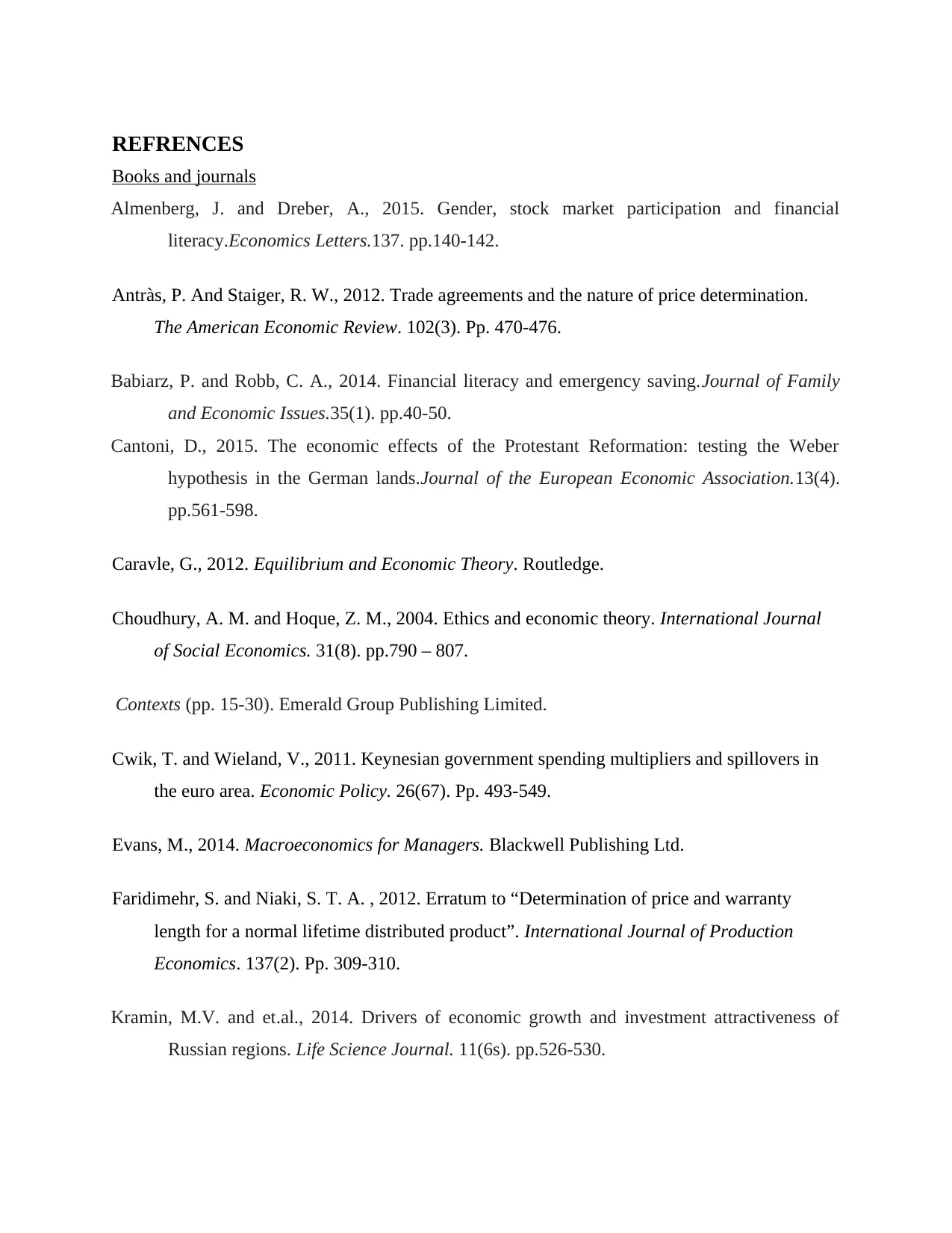
REFRENCES
Books and journals
Almenberg, J. and Dreber, A., 2015. Gender, stock market participation and financial
literacy.Economics Letters.137. pp.140-142.
Antràs, P. And Staiger, R. W., 2012. Trade agreements and the nature of price determination.
The American Economic Review. 102(3). Pp. 470-476.
Babiarz, P. and Robb, C. A., 2014. Financial literacy and emergency saving.Journal of Family
and Economic Issues.35(1). pp.40-50.
Cantoni, D., 2015. The economic effects of the Protestant Reformation: testing the Weber
hypothesis in the German lands.Journal of the European Economic Association.13(4).
pp.561-598.
Caravle, G., 2012. Equilibrium and Economic Theory. Routledge.
Choudhury, A. M. and Hoque, Z. M., 2004. Ethics and economic theory. International Journal
of Social Economics. 31(8). pp.790 – 807.
Contexts (pp. 15-30). Emerald Group Publishing Limited.
Cwik, T. and Wieland, V., 2011. Keynesian government spending multipliers and spillovers in
the euro area. Economic Policy. 26(67). Pp. 493-549.
Evans, M., 2014. Macroeconomics for Managers. Blackwell Publishing Ltd.
Faridimehr, S. and Niaki, S. T. A. , 2012. Erratum to “Determination of price and warranty
length for a normal lifetime distributed product”. International Journal of Production
Economics. 137(2). Pp. 309-310.
Kramin, M.V. and et.al., 2014. Drivers of economic growth and investment attractiveness of
Russian regions. Life Science Journal. 11(6s). pp.526-530.
Books and journals
Almenberg, J. and Dreber, A., 2015. Gender, stock market participation and financial
literacy.Economics Letters.137. pp.140-142.
Antràs, P. And Staiger, R. W., 2012. Trade agreements and the nature of price determination.
The American Economic Review. 102(3). Pp. 470-476.
Babiarz, P. and Robb, C. A., 2014. Financial literacy and emergency saving.Journal of Family
and Economic Issues.35(1). pp.40-50.
Cantoni, D., 2015. The economic effects of the Protestant Reformation: testing the Weber
hypothesis in the German lands.Journal of the European Economic Association.13(4).
pp.561-598.
Caravle, G., 2012. Equilibrium and Economic Theory. Routledge.
Choudhury, A. M. and Hoque, Z. M., 2004. Ethics and economic theory. International Journal
of Social Economics. 31(8). pp.790 – 807.
Contexts (pp. 15-30). Emerald Group Publishing Limited.
Cwik, T. and Wieland, V., 2011. Keynesian government spending multipliers and spillovers in
the euro area. Economic Policy. 26(67). Pp. 493-549.
Evans, M., 2014. Macroeconomics for Managers. Blackwell Publishing Ltd.
Faridimehr, S. and Niaki, S. T. A. , 2012. Erratum to “Determination of price and warranty
length for a normal lifetime distributed product”. International Journal of Production
Economics. 137(2). Pp. 309-310.
Kramin, M.V. and et.al., 2014. Drivers of economic growth and investment attractiveness of
Russian regions. Life Science Journal. 11(6s). pp.526-530.
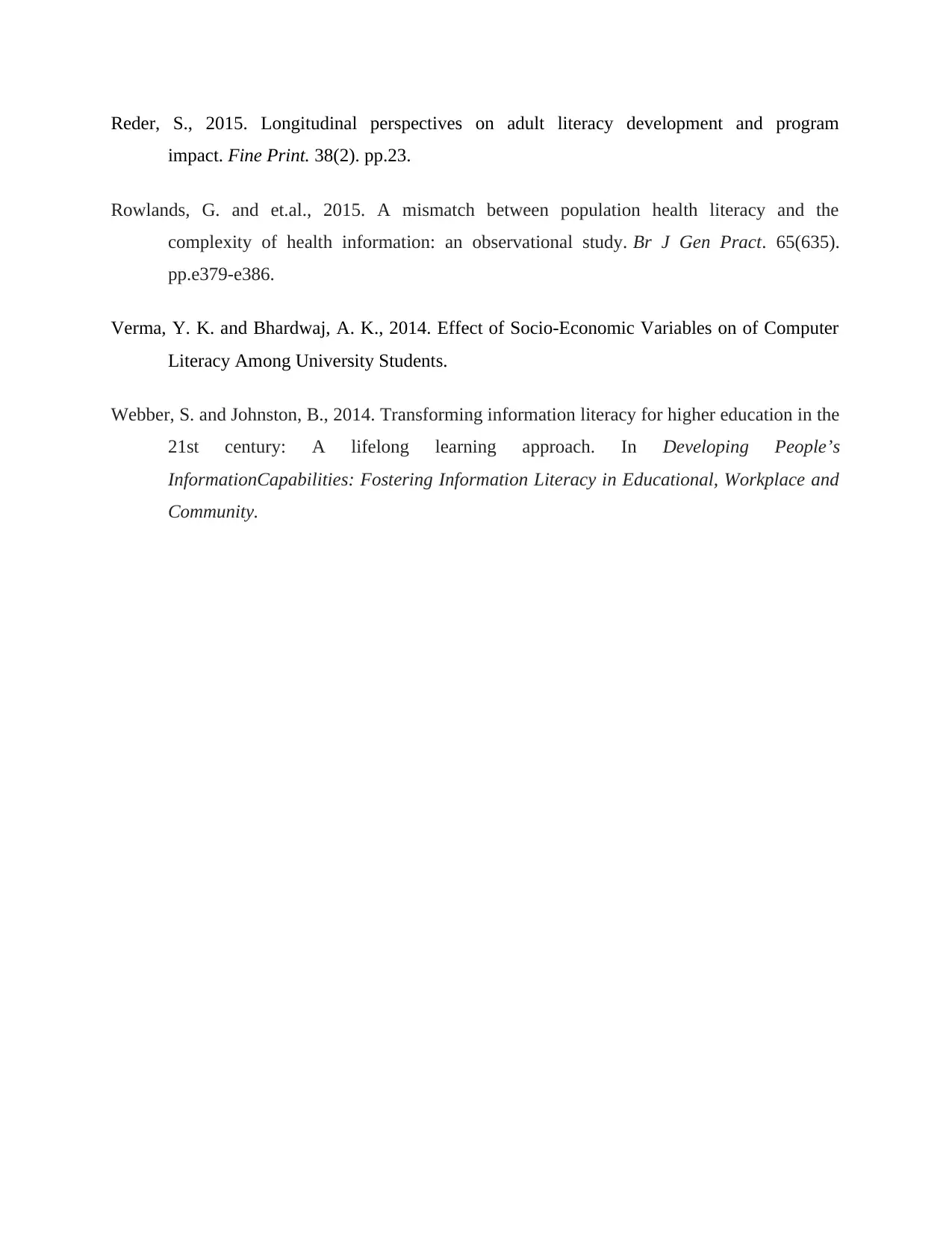
Reder, S., 2015. Longitudinal perspectives on adult literacy development and program
impact. Fine Print. 38(2). pp.23.
Rowlands, G. and et.al., 2015. A mismatch between population health literacy and the
complexity of health information: an observational study. Br J Gen Pract. 65(635).
pp.e379-e386.
Verma, Y. K. and Bhardwaj, A. K., 2014. Effect of Socio-Economic Variables on of Computer
Literacy Among University Students.
Webber, S. and Johnston, B., 2014. Transforming information literacy for higher education in the
21st century: A lifelong learning approach. In Developing People’s
InformationCapabilities: Fostering Information Literacy in Educational, Workplace and
Community.
impact. Fine Print. 38(2). pp.23.
Rowlands, G. and et.al., 2015. A mismatch between population health literacy and the
complexity of health information: an observational study. Br J Gen Pract. 65(635).
pp.e379-e386.
Verma, Y. K. and Bhardwaj, A. K., 2014. Effect of Socio-Economic Variables on of Computer
Literacy Among University Students.
Webber, S. and Johnston, B., 2014. Transforming information literacy for higher education in the
21st century: A lifelong learning approach. In Developing People’s
InformationCapabilities: Fostering Information Literacy in Educational, Workplace and
Community.
1 out of 16
Related Documents
Your All-in-One AI-Powered Toolkit for Academic Success.
+13062052269
info@desklib.com
Available 24*7 on WhatsApp / Email
![[object Object]](/_next/static/media/star-bottom.7253800d.svg)
Unlock your academic potential
© 2024 | Zucol Services PVT LTD | All rights reserved.





